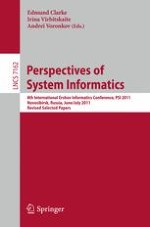This book contains thoroughly refereed and revised papers from the 8th International Andrei Ershov Memorial Conference on Perspectives of System Informatics, PSI 2011, held in Akademgorodok, Novosibirsk, Russia, in June/July 2011. The 18 revised full papers and 10 revised short papers presented were carefully reviewed and selected from 60 submissions. The volume also contains 5 invited papers covering a range of hot topics in computer science and informatics. The papers are organized in topical sections on foundations of program and system development and analysis, partial evaluation, mixed computation, abstract interpretation, compiler construction, computer models and algorithms for bioinformatics, programming methodology and software engineering, information technologies, knowledge-based systems, and knowledge engineering.
